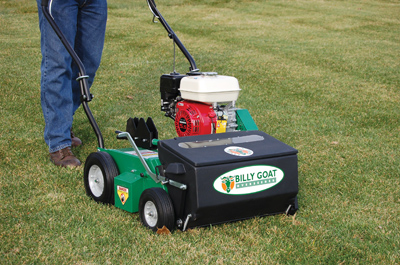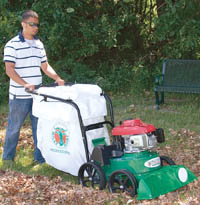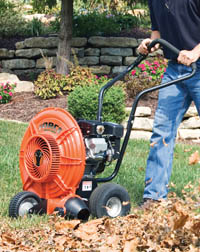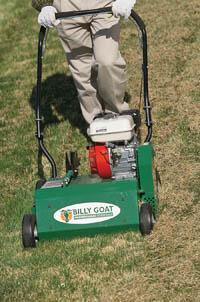
Spring forward
By Pierre Pereira
ProductsUnderstanding demand during the lawn and garden season will increase revenue, improve return on invested capital (ROIC) and help customers.
Understanding demand during the lawn and garden season will increase revenue, improve return on invested capital (ROIC) and help customers.
 |
|
| Overseeders can be rented twice a year, in March and September.
|
After a long winter and wet spring, waterlogged yards begin to dry out and customers begin the annual ritual of renting equipment and preparing lawns for the outdoor summer fun ahead. After assessing the damage caused over the prior year by drainage, shade, soil ph, soil compaction, high foot traffic, pests, and thatch – customers need equipment and advice to renovate their properties. Luckily, simple problems such as thatch, bare spots and soil compaction are easily solved by renting power rakes (de-thatchers), overseeders and aerators – and proper advice on fertilization, mowing, watering and drainage typically resolves the other issues, improves customer satisfaction and generates re-rentals. Here’s a list of equipment and general advice to keep lawn and garden rental revenue flowing and customers happy.
 |
|
| Leaf collection using a rag and bag is tedious. Do your customers know that there’s a better way? Advertisement
|
March:
Leverage spring cleanup by advertising and displaying items such as outdoor vacuums, chippers, aerators, power rakes overseeders and walk-behind blowers. Customers are in the midst of spring cleanup of sticks, blooms, seeds and leftover leaves.
Recommend a two-step rental process: Early in the month, clean the property with blowers, vacuums and chippers – and later in the month, before grass starts to grow, rent a power rake to remove thatch accumulation from the prior year. Excess thatch prevents water and nutrients from reaching the soil and may contribute to turf disease.
Rental of overseeders for any thin spots that may appear or were missed by customers in the fall is also ideal. For shade areas, recommend that they overseed with shade-tolerant mixes. For northern grasses, mixes of bluegrass, fescue and rye are most common.
As an added service, you might also take a moment to offer your customer soil testing as a service or refer customers to the local nursery or garden center to determine acidity. Generally, a pH of 6.0 to 7.0 is desired for a healthy lawn. If the pH is less than 5.0, a healthy balance can generally be achieved by applying lime at a rate of 50 pounds per 1,000 square feet. Also, determine the right trencher to help repair any drainage issues that may have occurred during the winter and spring. Customers generally set mole traps during this month, so consider placing them at or near the counter.
 |
|
| There is a season for every piece of equipment. When the winds of autumn blow, you can help with blowers. |
April:
Customers typically apply crabgrass preventer by April 15 and start their mowing regimen soon thereafter. If you are asked, between two- and three-inch mowing height is recommended to hold in water, discourage weeds and promote deeper roots. At this time, spring aeration begins if the yard is heavily compacted. Aeration improves root depth as well as air, water, fertilizer and nutrient flow. Customers should feel free to leave the plugs on the lawn, as they will be mulched back after a few rains and cuttings. However, if they want to pick them up – wait a day or two for them to dry and rake or vac them up. Watering the night before is recommended to soften the soil and allow core depths to three inches.
May:
Keep spreaders available as customers begin to fertilize when the rapid spring growth begins to slow. Most lawns will not need more the one pound per 1,000 square feet in May and again in September. In early June, as the season begins to dry out, recommend that customers start their regular morning watering routine (before 8 a.m.), but do not overwater, as it can promote fungal growth. Water just enough to take off drought stress. As a rule of thumb – consider no more 3/4 to 1.5 inches total per week, depending on climate. Sell and rent sprinklers.

|
|
| How dedicated are your homeowner customers to lawn care? They might not be able to afford to purchase professional-grade landscaping equipment, but they might be able to rent it. |
August:
Recommend pesticide applications for grubs if the population exceeds nine grubs per square foot only. If the population is below that, they are unlikely to cause damage to customers’ root systems. Keep in mind, if the lawn is lush and healthy, a small population may be in balance and not causing enough damage to justify the expense. So, keep spreaders out. Also, this month is ideal to begin brush cutting. Put your pedestrian brush cutters front and centre – they will cut down brush up to six feet high at a rate of about an acre per hour.
September:
After lawns take a beating from the summer heat and recreation schedule, customers start fall aeration, overseeding and fertilizing this month. It is the best month for customers to rejuvenate cool-season grasses such as rye, fescue and blue grasses. It is a month with minimal weed pressure, cooler temperatures and increased moisture, which makes conditions ideal. Aerating, overseeding, and fertilizing lawns is just the answer to rejuvenate them. Have your fleet ready again. Recommend a crisscrossing diagonal pattern for overseeders at half the drop rate. Consider new hydrostatic overseeders that improve productivity and eliminate the fatigue factor for customers.
October / November:
Rent walk-behind leaf blowers and leaf vacuums to keep leaf drop from packing and smothering grass. Prepare the snow thrower rentals and repeat in the spring. Enjoy the revenue flow, improved ROIC and happy customers.
Pierre Pereira is the vice-president of sales and marketing for Billy Goat Industries.
| WHAT TO RENT
March April May August September October/November |
Print this page
Leave a Reply